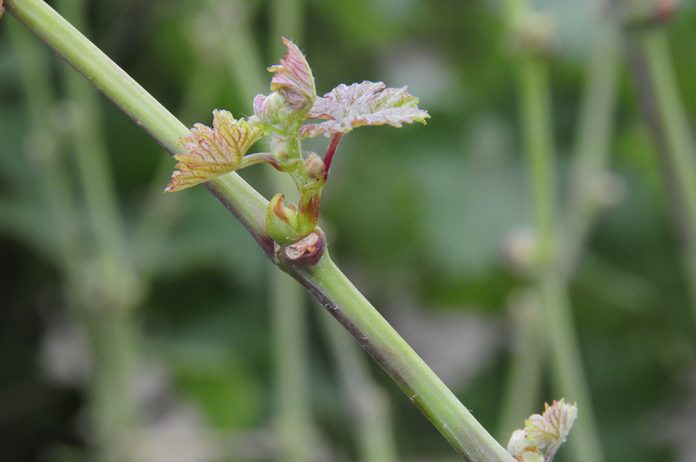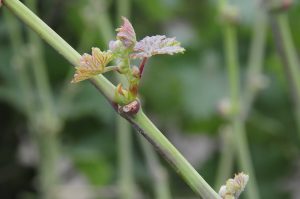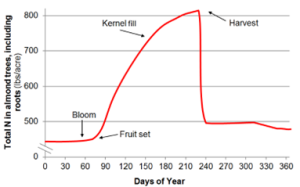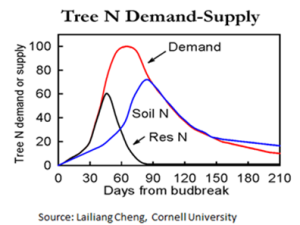
Studies and best practice examples corroborate it: When it comes to tree and vine postharvest fertilization, including fertigation is fundamental to ensure next season’ s crop success. It is that time of year to remind ourselves the season is not over after harvest.
Why Postharvest?
Fertigating at this stage is good for the roots. After the fruits have been collected, studies show, roots become the stronger sink for carbohydrates to fuel their growth, and access to readily available essential macronutrients and micronutrients such as nitrate and potassium can boost their development.
It may seem like nothing is happening with the grapevines after the grapes are harvested, the reality is different. After the harvest, vines continue to allocate resources; from the soil, grapevines are taking up nutrients and minerals, and with the process of photosynthesis, they create carbohydrate reserves and store them in permanent wood structures (roots and trunks). Therefore, the postharvest period is one of the most important periods for nutrient uptake, and carbohydrate reserves are used by vines for respiration during dormancy and for fueling new growth the following season. Next season’s grape crop from budbreak to flowering relies solely on stored carbohydrates. Early shoot and root development, flowering and even fruit set are linked to those stored carbohydrates from the postharvest period.

Nutrient storage is important in all permanent crops. After heavy fruit and nut loads, the tree’s nutrient reserves are significantly reduced. Postharvest fertilizer, provided leaves are still photosynthetically active, will assure the tree can reload nutrient reserves to be well prepared to support next season’s early development. Tree crops grown in cooler climates with low temperatures during dormancy in winter will be faced with low soil temperature in early springtime and therefore limited root activity, even if ambient temperature is mild. In these conditions, tree crops and grape vines mainly rely on stored nutrients in the stem and roots.

In the case of many tree fruit and nut crops, postharvest applications through foliar or fertigation could also reduce the “on-off” years incidence, where one year of heavy fruit load is followed by a year of low fruit yield. This phenomenon may be related to depleted nutrient stocks in the tree after heavy fruit load and nutrient export with harvested fruits from the orchard, rendering the tree crops unable to support a consecutive year of abundant fruit yield.
At the early bloom and fruit initiation stage, the tree fully depends on nutrient reserves, stored in the tree itself. The most important nutrients needed to top off at this period are nitrogen (N) and potassium (K), and up to 30% of total annual application of N and K should be applied. It is important to select readily available nutrient sources such as potassium nitrate, which will provide immediately available N in the form of nitrate, while tree crops need to be replenished with K as significant amounts of K are exported with the harvested fruits from the orchard.

In the case of almonds, nitrogen can be applied any time after hull split up until a few weeks postharvest. In earlier harvested varieties and ‘Nonpareil,’ N can be applied shortly after harvest with the first postharvest irrigation. With later varieties like ‘Monterey’ or ‘Fritz,’ the application can be made post-hull split prior to harvest. This timing matches bud development that tends to occur about two weeks after ‘Nonpareil’ harvest for most varieties. Postharvest K applications may be a reasonable strategy if you are on soil that is able to hold the K. In sandy soils, K can be leached out of the rootzone, which may create a situation of deficiency in the following year.
In the case of grapes, the period after harvest but before leaf fall is one of the best times of the season for the uptake of N and K which the vine needs along with carbohydrates to provide for the period of rapid shoot growth in the spring after budbreak. This is encouragement to deliver these macronutrients after harvest when excessive growth and the K content of the fruit is not a concern. Replacing minerals is important as they are transported off-site in the crop. Even if some of these are recycled back into the soil like with leaves or canes, that recycling is slow and inadequate to provide the needed plant nutrients.

In Research
There are two main stages of root growth. In a rhizotron study conducted in Chile in 1993 with two table grape varieties (Flame Seedless, Muscatel), it was shown that the first (and larger) peak root growth stage takes place from budbreak to petal fall/fruit initiation. The second (and smaller) peak root growth stage takes place after fruit harvest until leaf fall (postharvest). Root development is linked to the competition for carbohydrates between roots and developing fruits. Developing fruits are stronger sinks for carbohydrates produced in the leaf than roots. Therefore, root growth and development are suppressed during fruit development growth stages. Once the fruits have been harvested, roots become the stronger sink for carbohydrates to fuel their growth. Access to readily available essential macronutrients and micronutrients, applied with fertigation during postharvest, is equally essential to support root development. The recommended dose rate of nutrients in fertigation is to be decided by plant-soil-water diagnostics.
References
“Balanced soil fertility management in wine grape vineyards.” Grant, S. Practical Winery May/June 2002.
“Best Management Practices for Nitrogen Fertilization of Grapevines.” Peacock, B., Christensen, P. and Hirschfelt, D. University of California Cooperative Extension.
“Foothill Vineyard Post Harvest Activities: FERTILIZING: Information summarized from ‘Grapevine nutrition and fertilization in the San Joaquin Valley.’” Christensen, P., Kasimatis, A. and Jensen, F. UC ANR pub. 4087 (the “black book”) now out of print.” L.R. Wunderlich, UCCE Farm Advisor. Foothill Vineyard News, Issue 9, October 2013.
“Post-harvest Vineyard Management: Growers Guide for Riverina Vineyards.” Edited by Hackett, S. and Bartrop, K.. Riverina Wine Grapes Marketing Board. March 2011.
Resources
Almond Nutrients and Fertilization: fruitsandnuts.ucdavis.edu/crops/almond
Tree Fruit Soil Fertility and Plant Nutrition in Cropping Orchards in Central Washington: treefruit.wsu.edu/orchard-management/soils-nutrition/fruit-tree-nutrition/
















